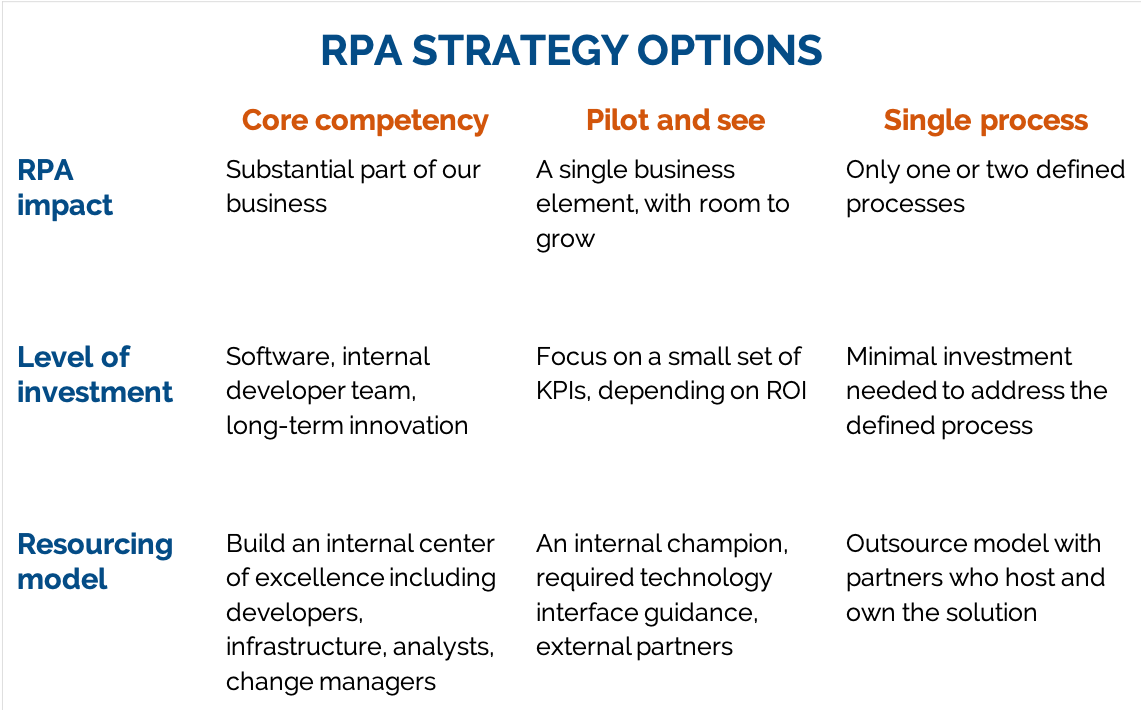Robotic Process Automation (RPA) involves the use of bots or artificial intelligence to emulate human keystrokes and mouse clicks to automate rote tasks – thus saving on labor costs and tedious processes. In this case study of a Mod Op Strategic Consulting client, we offer some valuable lessons for how leaders of any company or organization can make RPA work for them.
Robotic Process Automation (RPA) has been getting a lot of buzz lately, for its promise to reduce manual work, accelerate operations and enable new products and services. While RPA offers huge potential, there are plenty of challenges that can impact a company’s ability to realize the promised benefits. To help you realize the full potential of RPA, below are five lessons learned from a recent project establishing an automation center of excellence for a client in the global financial services industry.
RPA is software that emulates human keystrokes and mouse clicks in order to automate rote tasks. RPA designers create automated processes using bots or artificial intelligence (AI) to copy and paste data, run calculations, format files and more. RPA is often used on high volume or strategic processes to improve scale and cycle time while reducing errors and risk.
This case study explores key takeaways from our most recent experience with RPA:
Select the right pilot opportunity to demonstrate proof of concept (POC). While it might be tempting to tackle more complex business processes, an essential objective of the POC is to prove the viability and value that RPA provides. Keep in mind that RPA requires a substantial shift in the organization to address internal process, IT, and compliance to achieve a sustainable automation program. In our example, the first launch was delayed by a month due to the need to align on a standard file format and secure adequate resources for testing. We recommend:
-
- Selection: choose a simple process with clearly defined key performance indicators (KPIs) that can be used to measure the impact in real terms (manual hours, cycle time, quality). Back-office processes are preferred to limit exposure to customers.
- Preparation: Schedule adequate time to define the process from end to end before trying to automate it. This includes the steps, inputs and outputs, service level agreements and organizational elements that need to be considered.
- Support: Enlist key stakeholder support for the program (from executives to the execution team) to provide adequate resourcing. Include subject-matter experts (SMEs) for solution requirements and testing and leaders to support the organizational change needed to adopt the automated process.
Define your level of investment and resourcing – and begin planning immediately. Almost as bad as a failed POC is a successful POC that fails to build momentum because of delays in required resources. Because skilled RPA developers and analysts are difficult to hire, companies that see RPA as a strategic growth platform are encouraged to define and initiate their resourcing strategy in parallel with the POC. Assuming the POC is successful, companies typically choose between the models illustrated below. In Mod Op Strategic Consulting’s most recent case, the client chose a hybrid approach, leveraging external consultants (option 2) to develop the pilot while simultaneously initiating the search for talent to staff the ongoing program (option 1) by pilot launch.
Engage compliance and information security early and often. RPA should be considered a disruptive technology. As such, it is critical that compliance and information security teams understand RPA not just conceptually, but also how specific automation projects will impact current processes. In the recent project example, we did not spend enough time getting compliance buy-in on the proposed solution before starting development, requiring rework to meet internal standards. To avoid this rework loop, we recommend:
-
- Establish the project objectives and educate the team on basic RPA mechanics.
- Once a project has been identified, engage again to walk through the solution and proactively call out specific areas of change, open concerns and opportunities.
- Reengage once the solution has been identified to make sure alignment.
- Find ways to enhance existing control and compliance to increase credibility and buy-in.
Integrate into your larger technology assessment process. Most companies have a standard technology assessment, approval and resourcing structure to ensure consistency and accountability and to optimize scarce development resources. While it’s a good idea to pilot RPA in an appropriate POC staging space, RPA projects – when validated – should quickly move into the mainstream assessment and be subject to the same review, approval and allocation process as other solutions. This ensures RPA is held to the same standards and evolves from special project to core competency. In our recent example, the client moved quickly to include RPA projects in their core project submission review process, ensuring greater visibility, platform stability and organizational acceptance.
Communicate the concept, then get real. While the concept of RPA automation is easy to grasp, the nuts and bolts of what makes a good project and where to find them in your organization requires more than an introductory Powerpoint. Indeed, after introducing RPA to its business leaders, our client found it necessary to follow up with brainstorming sessions and process deep dives to identify relevant opportunities. To ensure the organizational adoption needed, we recommend:
-
- Engage stakeholders on the concept as part of a digital or operations strategy
- Follow up with tangible examples (like your POC), using process maps, step by step videos and output examples.
- Conduct brainstorming sessions or empower internal SME’s to identify and submit new projects based on a stronger understanding of what makes a successful RPA project
A well-executed RPA strategy can unlock significant value in efficiencies, process control and new product development. Take advantage of these lessons learned to accelerate your own program or contact us and see how Mod Op Strategic Consulting can help.

















